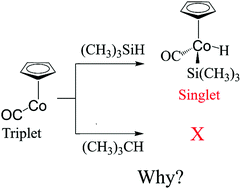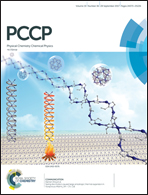Using a non-spin flip model to rationalize the irregular patterns observed in the activation of the C–H and Si–H bonds of small molecules by CpMCO (M = Co, Rh) complexes†
Abstract
The activation of the C–H and Si–H bonds of CH(CH3)3 and SiH(CH3)3 molecules by organometallic compounds CpMCO (M = Co, Rh) has been investigated through DFT and CASSCF-MRMP2 calculations. In particular, we have analyzed the pathways joining the lowest-lying triplet and singlet states of the reactants with the products arising from the insertion of the metal atom into the C–H or Si–H bonds of the organic molecules. Channels connecting the reactants with the inserted structure Cp(CO)H–M–C(CH3)3 through the oxidative addition of the C–H bond of the organic molecule to the metal fragment were found only for the reaction CpRhCO + CH(CH3)3. However, inserted structures could also be obtained for the interactions of SiH(CH3)3 with CpCoCO and CpRhCO by two sequential reactions involving the formation and rebounding of the radical fragments Cp(CO)H–M + Si(CH3)3. According to this two-step reaction scheme, the complex CpCoCO is unable to activate the C–H bond of the CH(CH3)3 molecule due to the high energy at which the radical fragments Cp(CO)H–M + C(CH3)3 are located. The picture attained for these interactions is consistent with the available experimental data for this kind of reaction and allows rationalization of the differences in the reactivity patterns determined for them without using spin-flip models, as has been proposed in previous studies.



 Please wait while we load your content...
Please wait while we load your content...